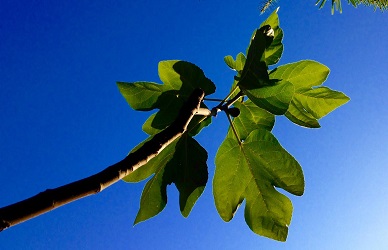
I enjoy making fig jam in late summer (especially rich Mission Fig jam), but fruit isn't the only culinary ingredient a fig tree yields — fig leaves make an unusual syrup that's perfect for glazing savory and sweet foods (it's a nice alternative to maple syrup for pancakes, too). My recipe below presents you with two options: liquid fig leaf syrup or fig leaf jelly. If you want jelly, all you need to do is set the syrup with pectin in step no. 6 below and use jars instead of bottles.
Fig Leaf Syrup / Jelly
(yields approximately eight cups of syrup or jelly)
15 large fig leaves from an insecticide-free tree (rinse the leaves with cold water before use, and if the leaves are huge you may cut them in quarters). If your fig trees grow near a busy road where they are exposed to constant exhaust fumes, buy your fig leaves from a grocery store!
5 cups filtered water
4 cups dark, rich honey (or 2 cups honey and 2 cups treacle)1. Both versions have a lovely coconut-like flavor from the fig leaves, but the honey-treacle combination, of course, has a lighter honey flavor.
Heat-resistant swing-top glass bottles with ceramic caps and rubber/silicone gaskets or jelly jars.

1. In a large stainless steel pot, combine the water and honey (or water, honey and treacle). Bring the sweetened water to a simmer and remove the pot from the heat source.
2. Put the washed fig leaves into a large heat-proof glass bowl and pour the hot, sweetened water over the leaves, making sure the fig leaves are covered completely with liquid. Cover the glass bowl with a clean cotton dish towel until the mixture cools.
3. When the mixture is room temperature, place a double layer of plastic wrap over the bowl and let the mixture “cure” at room temperature for a day.
4. NEXT DAY (ready to process): sterilize glass bottles or jars and their accompanying caps/gaskets or bands/lids.2
5. Gently squeeze the fig leaves over the glass bowl and discard the leaves. Strain the (leafless) liquid through a jelly bag.
6. For syrup, heat the strained liquid to a boil and immediately remove from the heat. For jelly, heat the strained liquid to a boil and add pectin (following the manufacturer's instructors for amounts and cooking time).
7. Pour your syrup/jelly into the sterilized bottles or jars, clean off any sticky syrup residue from the bottles' or jars' rims with a clean, damp towel; put on caps/gaskets or lids/bands and water process for 10 minutes.2
Your syrup or jam will last up to two years but tastes best if used within a year; store in the refrigerator after opening.

One of my favorite uses for fig leaf syrup is in a vodka cocktail (add just a little syrup at a time till you find your ideal vodka/syrup ratio); instead of the usual sliver of citrus at the glass's rim, use a fig slice. For those of you with a sweet tooth, drizzle some fig leaf syrup over fresh figs (cut in half) and serve with thin slices of toasted olive oil-and-orange rind pound cake and cheddar or goat cheese.
Happy autumn to all NST'ers!
1. Often sold as "Golden Syrup."
2. For in-depth (and helpful) canning and canning safety instructions see Ball/Kerr’s website or the Department of Agriculture/National Center for Home Food Preservation online instruction documents.
Note: all photos by the author.
Thank you! I’ve been looking forward to trying this recipe since you mentioned it before. The fig by Mom’s sidewalk needs a trim so I will try making a batch next week.
MM, enjoy!
Wooo-hooo!!! I’ve been hoping you’d post this; can’t wait to try it out. Thanks!!!
Liza, you’re welcome!
I am trying this and your rose jam today! I have altered the fig syrup a bit (as any cook tends to do!). I did not find treacle, but I liked the idea of a less honeyed flavor. So, I made a simple, heavy syrup with sugar for the balance of the 2 cups of sweetener. I will report back how it all goes!
Thank you for sharing your recipes, Kevin! May your garden always be plentiful. 🙂
Just stuck the fig syrup jars into the hot water bath now. . . I decided to add a tsp or two of vanilla extract, since I will likely be using this as pancake syrup or yogurt flavoring (I’m not a drinker). It’s tasty, but perhaps a bit too sweet . . . making a note to reduce the sugar next time. Such fun to play in the kitchen, in any case!
The rose jam is amazing! My roses are deep red and light pink. The jam has an amazing deep pink color. I used lime juice, but I didn’t macerate the flowers first. I *did* freeze the prepared petals until I had enough, since it is late in the season and I didn’t have 10 blooms at once. The texture seems good anyway! And the smell! This recipe will definitely join my summer rotation. Thanks, again, Kevin!
MR: SOOOO glad the recipes worked for you! Do let me know how you like the fig syrup!